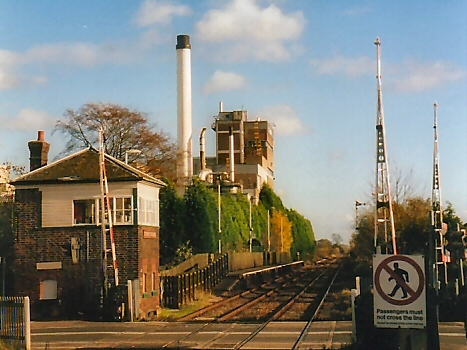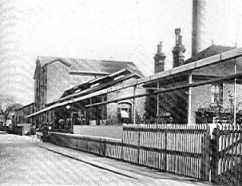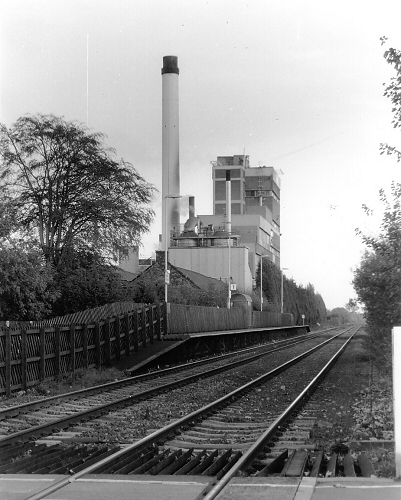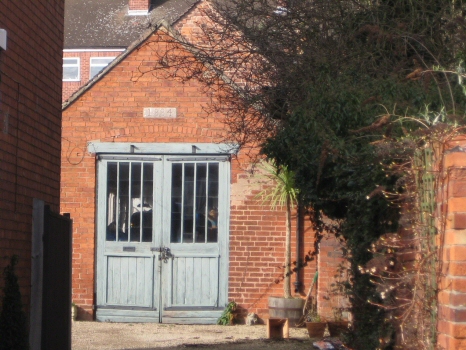Local Industries
Some Historical Information
Nestle's Factory
The factory is on the Hatton (Derbyshire) side of the River Dove which forms the boundary with Tutbury (Staffordshire).

The date 1901 still appears on the left-centre block recording the year the Nestle Anglo-Swiss Condensed Milk Company built on this site and began to process milk from local farms, making use of the adjoining North Staffordshire Railway.
In World War ll, dehydrated skimmed milk, dried powdered eggs, Red Cross food parcels and survival ration kits were packed here.
The beginnings of Nescafé can be traced back to 1930, when the Brazilian government challenged Nestlé to create a coffee that could be made simply by adding water but which retained the coffee's natural flavours.
After seven years of development by a Swiss research team, NESCAFÉ was born and the breakthrough was introduced to the world on April 1st 1938.
During WWll, it became the staple beverage of the US armed forces and, from then on, its popularity really took off. By the 1950s, coffee was the 'in' drink for the young rock'n'roll generation who flocked to the new coffee bars.

In the 1950s there was extensive re-building so that this view down Marston Lane around 1910 is much altered today.

From 1959 the factory began instant coffee production and and is one of only two factories in the country that produces the Nestlé range.
Nestles first introduced Nescafe from the continent in 1938 but it was post-war that it became a big marketing success, largely responsible for the rapid growth in coffee consumption.
In 1966, 6.3 cups of tea were still drunk for every cup of coffee; the gap in 1984 was 2 to 1 in favour of tea and this factory's annual output was the equivalent of 3,250 million cups of coffee.
Today, Nescafé is the world’s favourite coffee, we British drink a massive 15,000 cups of Nescafé every minute.
Artificial Fly Tying
An unusual, but flourishing, local industry was that of artificial fly tying, the making of the lure.This business was formed by Roger Woolley. He was a professional fly tyer and author of that near classic 'The Fly Fishers Flies'.
Roger, to all his friends, was an authority in this art. He says in a preface to his book, and I quote "'The art of choosing the right fly at the right moment is often the decisive factor between tight lines and tall stories" unquote. His knowledge was passed on to others in the business and is still being used.
The firm of Roger Woolley & Co. Ltd. at 3 Bridge Street was a family business in the old days, his four daughters being directors with Mr. Woolley managing. Upon his decease, the business was taken over by Miss Rosa Smith his senior tyer.
Grice & Co - Funeral Directors
The property in Monk Street was originally used as a Malthouse.

The founder of the carriage building and wheelwright firm was Mr. Samuel Grice, the grandfather of the late Miss Mary Grice, who will still be remembered by some of the senior members of our local community. Mr. Samuel Grice purchased the property in 1859, after previously using workshops on High St, Tutbury and a location somewhere in Anslow. Mr. Samuel Grice married and there were five sons and three daughters. Two maiden aunts of these children ran a private school in Castle St. The schoolhouse was eventually divided into two dwellings now known as 28 and 28a Castle St.
Mr. Samuel Grice in 1918 leaving the business to his son Mr. John Henry Grice. Soon afterwards, he formed a partnership with a Mr. Horace Marler, an excellent craftsman who was employed by the firm at that time. The firm then became known as "Grice and Marler".
About this time, Grice and Marler acquired the use of the Castle St property which had originally been the coach-house and stables of Tutbury vicarage. The machining was done there. The circular saw, band-saw and planing machine were all powered by a Crossley gas driven motor. The bulk of hardwood was received from the timber merchants at Castle St where it was carefully stacked outside where 1" thick strips were placed between each plank to allow the planks to `breathe'.
The partnership continued until Mr. Marler left the firm in 1937. The work-force comprised one senior man named Mr. George Furr, Mr. Eric Thompson and Mr. J Cooke - aged 14. The funeral business in rural areas at that time was divided into self employed craftsmen who were prepared to "undertake" these duties for bereaved families. In the Tutbury area there were 4 firms and in most villages a similar situation applied. Smart advertisements were not known in those days and personal trust was the norm. It was a fairy common procedure for a male member of the bereaved family to visit the workshop to inspect the coffin as it was being made.
The onset of war made few changes at the beginning, but as the months went by there were more and more restrictions. For the repair and maintenance of farm vehicles there was no difficulty in obtaining home-grown hardwoods, but imported softwoods became very short in supply. The petrol shortages meant that there was an increase on the repairs and renovations of light horse-drawn vehicles such as pony traps and governess carts. The yard at Monk St. was literally crammed with horse-drawn vehicles and long hours of overtime were quite normal. Perhaps the most memorable of the vehicles was the Shetland Pony Stage-coach from Bertram Mills Circus, which spent most of the war years at "Vernon's Oak " in Sudbury.
During those years of war the firm was becoming established in a variety of skills and was willing and reliable noted in the business of funeral directing. When Mr. John Grice died in 1950, Mr. J Cooke took over as a partner to Miss Mary Grice. Miss Grice died in 1983. By this time the firm was busily engaged in funeral work to the exclusion of all other, until the retirement of Mr. Cooke in 1987.

